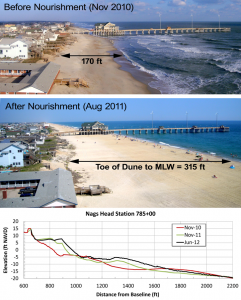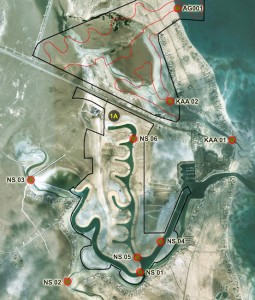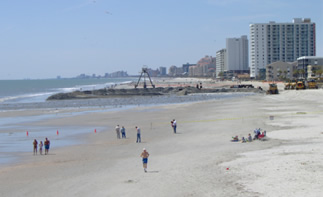
Kiawah Island after inlet relocation, Jul 2006
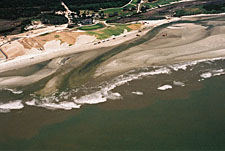
Kiawah Island before inlet relocation, Jun 2006
Restoration of the beach along the famed Ocean Course golf resort at Kiawah Island required closure of a tidal inlet, opening of a new inlet one mile away, and excavation of 550,000 cy from a ten-year-old barrier beach. The area of excavations was open ocean a decade ago. But in barely ten years, a 3-mile-long barrier island/lagoon system formed by way of shoal bypassing at Stono Inlet. An estimated 5 million cubic yards were added by natural processes at Kiawah’s eastern end. As the bypassing event progressed, it enclosed a 200-acre lagoon, added 150 acres of beach/dune/washover habitat, and left a flushing channel in front of the Ocean Course Club House.
Shoal bypassing is probably the single most important process along the South Carolina coast because it controls the sand exchange between inlets and beaches. Normally, Kiawah receives about 1 million cubic yards during a shoal-bypassing event. This produces localized accretion and erosion zones of a scale that are accommodated by healthy development setbacks established in the 1970s (at the recommendation of Professor Miles Hayes and others at the University of South Carolina).
The event in the 1990s that instigated the 2006 project dwarfed all previous shoal bypasses. Accretion zones moved the shoreline over 2,000 ft seaward (that is more than 250 ft/yr). However, erosion zones associated with the shoal-bypass cycle were also much larger than normal. Along the 18th fairway of the Ocean Course, dunes receded at over 100 ft/yr.
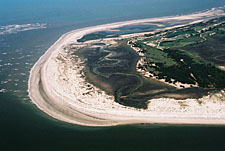
Kiawah Island before inlet relocation, Jun 2006

Kiawah Island after inlet relocation, Jul 2006
The 2006 project addressed the problem along the Ocean Course by relocating the new inlet and borrowing sand from the accretion zone. This was a cooperative plan developed in close coordination among the Town of Kiawah Island (lead entity), the Kiawah Island Golf Resort Company, SC DHEC-OCRM, SCDNR, US Army Corps of Engineers, and US Fish & Wildlife Service (USFWS). CSE was principal designer of the project. A critical element was protection of the incipient habitat of piping plovers.
Piping plovers are a threatened species and receive federal protection. Although they do not nest in South Carolina, they use certain isolated spits for roosting and foraging during parts of the year. The new barrier beach at Kiawah’s eastern end provides the type of ephemeral habitat favored by plovers. Because of its importance, USFWS required that all work be conducted outside the months when plovers may be present. This limited the construction window to June and July. However, because this is also the turtle-nesting season, extra protection measures for that species were implemented.
A principal goal of the project was to maintain as much washover habitat as possible while redirecting flows in and out of the lagoon through a new channel. The project removed sand that otherwise would have formed high dunes and become vegetated, a habitat plovers avoid. In this way, the project expanded the habitat for the piping plover.
The project also protected the Ocean Course. With some beach sections widened by over 500 ft, the project created a smoother transition between the accretion zone and the erosion zone. It restored downcoast sand transport (to other sections of Kiawah Island). And it allowed the Ocean Course officials to focus on the 2007 Senior PGA Championship, instead of the accelerating erosion along the 18th hole. Instead of sand being trapped by the shoal-bypass event east of the Ocean Coarse, beach sand now flows past the sand traps of the 16th and 18th fairways. Instead of a wave of erosion migrating along Kiawah Island, there is now the probability of a new cycle of accretion.
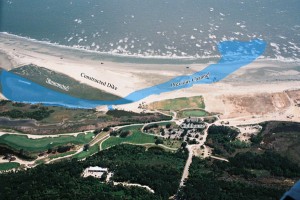
Ocean Course after inlet relocation – the original inlet, which threatened the course, is overlaid in blue.
A number of South Carolina beaches like Kiawah Island are gaining sand by natural processes. Barrier islands, lagoons, and even healthy stands of salt marsh can form in only a few years – as this project demonstrates. The 2006 project was an attempt to work with this healthy system. There will be no development in the project area and – it is hoped – no need for another project of this sort at Kiawah for many years.

